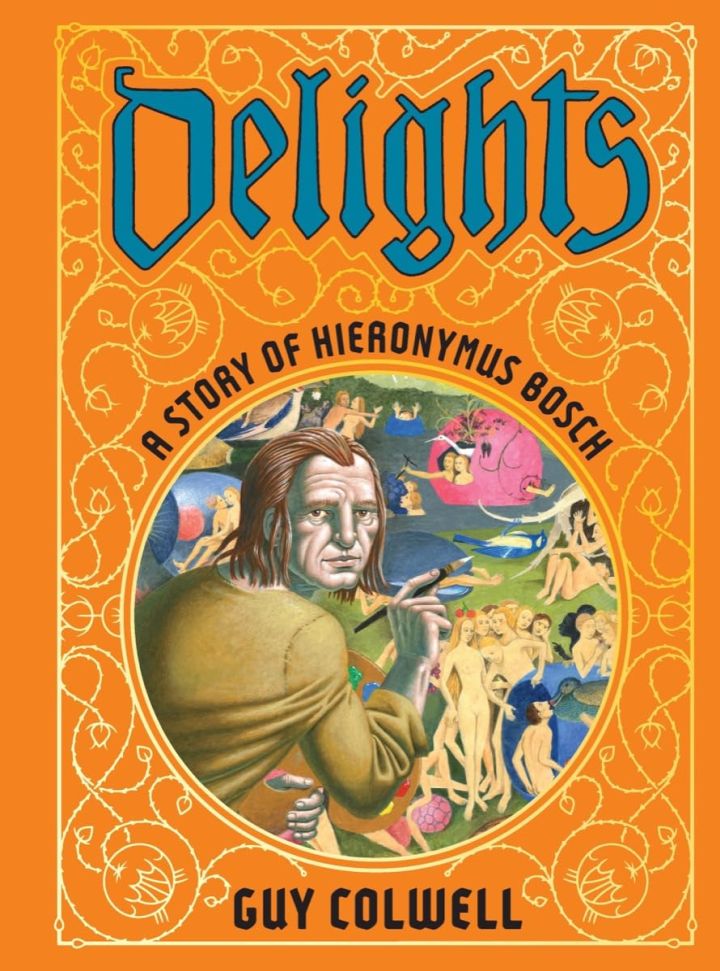
The Garden of Earthly Delights, by Hieronymus Bosch, is one of the most famous pieces of art in the history of the Western world. It’s an enormous and enormously detailed painting that covers three huge wood panels. There are the smaller side panels, and a larger center. The left panel is the Garden of Eden, with the Christ and Adam and Eve. The center is a fantasia of a world where the Fall never happened. Loads of naked people in various fantastic scenarios, with no notion of sin. Of course, this leads to the third, most famous panel.
Buy Delights: A Story of Hieronymus Bosch by Guy ColwellThat depicts Hell. It looks like an industrial hellscape at the top. Below that, bizarre monsters torment sinners on a landscape that is beyond description. How Bosch, real name Jeroen van Aken, came up with this endlessly fascinating depiction is not a well-documented story.
So, this graphic novel, Delights: A Story of Hieronymus Bosch, creates an interesting and somewhat historical account of how this masterwork might have been accomplished. Author Guy Colwell is an underground cartoonist and illustrator. In his introduction to this book, he relates his history with the work. He’s blended history, biography, and speculation into a fascinating portrait of the intersection of art, commerce, and religion.
Bosch was already a famous creator of religious artwork and a member of his religious order in good standing. He’s most well-known for his horrific visions of Hell and the creatures that might dwell there. It’s essentially stated early in the book that these are visions that come to him, real as life.
But Duke Engelbrecht and his nephew Hendrick want to commission something else from him. They know his reputation for excellence, and they want something secular they can display in their feast halls which show “naked pleasure seekers.” Surely, they can find something like that in the Bible, right?
Bosch is hesitant, but the money is good. And he, being a deeply devout man, can find justification in creating a scene where the fall of man never happened. And so, he begins to draw. Artists do not begin their masterworks right on the canvas – they make studies, they do tests. For all of these, Bosch uses a male model, for the male and female characters.
But this doesn’t satisfy the Duke’s nephew. He prefers his women to be women. So, he sends over a servant, a beautiful girl with no qualms about stripping in front of the artist. And when Bosch mentions his interest in depicting other races, well, the Duke seems to have an African servant in his back pocket to send as well.
All of this creates a dilemma for Bosch. He’s spending his entire day with hot, naked young people, posing in various scenes that begin innocently but hint towards debauchery. And the models make no secret of their hope Bosch might join in, himself.
Which sounds like the start of a porno comic. But Delights is not porno; it’s about the intersection of art, commerce, religion, and eros. Can an artist create an erotic artwork without erotic intent? Can he make a secular work while still maintaining his religious piety?
Bosch’s friends don’t think so, because they call in the Inquisition to examine the work. The Duke objects, because this is a secular commission.
One of the things I found most impressive in this book’s story is that Colwell, a modern writer, seems to understand Bosch’s medieval religiosity. He understands that this man truly believes. And follows through on the character, without imposing any unwelcome modernism on him.
And he respects his visions. Some of the most memorable passages of the book involve Bosch, when away from his work, confronted by the monsters of his imagination: why aren’t we in the painting? Aren’t we just as real as this fantasy of an unfallen world?
Colwell’s art style in this book is really cool. He doesn’t strictly ape medieval illustrations but references them in his compositions. The book’s sense of perspective is limited. There’s not a lot of 3D space, which is how etchings of the time looked. He doesn’t do strict primitivism, but hints enough at it to give the book a unique feel.
The dialogue is, too, pretty direct. Bosch and the other characters speak exactly what they feel. It’s not naturalistic, but it melds with the near primitivism of the artwork.
This is a very specific story, with a very specific audience. I’m in the audience, and so really enjoyed it. The actual book is lovely. The cover feels like faux-leather and is orange, which I imagine is because of Bosch’s Dutchness. I’m part-Dutch myself, and so must endure orange, but I don’t love it. There is a reproduction of The Garden of Earthly Delights on the back cover as a triptych including the folded-up outer painting of the Earth which shows the astounding piece of art in its entirety. I found this entire book engrossing, but I’m already a Bosch enthusiast. It’s idiosyncratic as hell. It’s also beautiful.
Delights: A Hieronymus Bosch Story has been released by Fantagraphics.